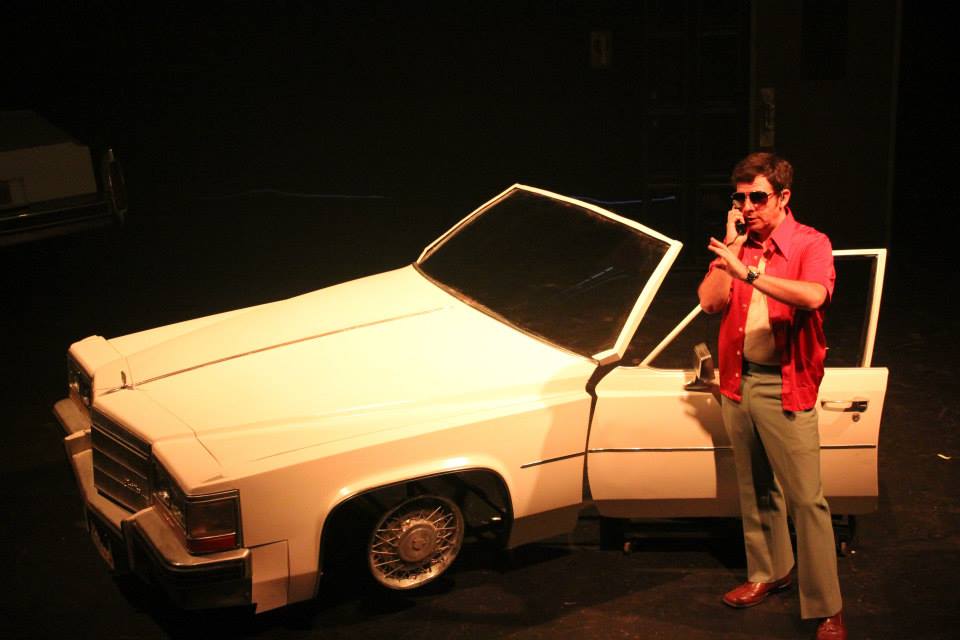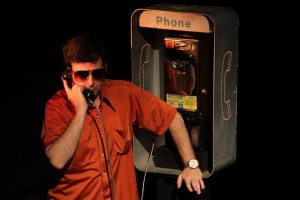
In THE INCREDIBLY DANGEROUS ASTONISHINGLY LUCRATIVE AND POTENTIALLY COMPLETELY TRUE ADVENTURES OF BARRY SEAL, co-creator co-director co-performer Thaddeus Phillips plays Barry Seal, a real-life, infamous drug smuggler-turned-DEA-informant who eventually gained the ire of both smugglers and government agents. The play takes place in a brief period towards the end of Seal’s life, when he is grounded, under government scrutiny, and unusually in the dark.
At the base of a column, a single door is installed. Downstage of that, a car door sits on a little wheeled platform. Stage left, a payphone, whose light turns on or off depending on whether it’s being used, and in other parts of the stage are other bits of Seal’s Cadillac.
The whole set (co-created by Phillips and Jeff Becker) winks at us—wink wink, you see what I’m doing. The idea for the play came on the set of Alias El Mexicano, the Columbian TV show on which Phillips plays the same character. See, says the set, this is how TV is made. With carefully framed slices of lie.
When Phillips strolls to the Cadillac door and sits down on the other side of it, leaning out the window and speaking into his sat phone, we believe he is in his Cadillac, even if we can see his shoes poking out. The lights are never down on the rest of the stage—we see the other parts of the car, the Salvation Army dorm room with DJ Mario Cotto (who designed the music and plays Seal’s roommate) in it, the payphone—and we are let in on the trick.
The scenes, except one or two or three key moments, are quick, focused, tight, like TV scenes. Seal strolls from space to space, emulating TV’s quick cuts, giving us new backdrops to keep us focused.
Seal is cool. In his aviator glasses, starched green suit, and slicked-back hair, he talks with confidence, ease, and an assumed dominance. Whether he’s threatening the vice president of the USA or reading Goodnight Moon to his daughter, the cool just radiates. It’s a tool, surely, for a man who’s been in so many near-death situations, and it’s also a weapon.
It’s also a theatrical device. When presenting us with a deeply ambiguous and potentially loathsome character, there has to be some charm, and Phillips has picked up on the charm of an otherworldly cool.

The first time Seal climbs the column to enter his cramped Salvation Army dorm at the top of it, he wins over his roommate with that same cool. He sits right down in an armchair, perfectly at home, and proceeds to tell him about a time he was almost murdered. His tone is the same you’d use discussing a conversation with a witty janitor. The same Columbians who helped him load up his plane with cocaine started shooting at the the second they took off—and only Seal’s “lucky satellite phone,” which costs $22 a minute, saved his life.
In scenes like these, the story—and the writing, well tuned to the character’s voice—carry the moment.
The rest of the play is conversations over the phone with various people—ex-partners, girlfriends, wives, kids, government officials—where Seal attempts to wheel, cajole, charm, and threaten his way out of his increasingly bad situation.
About midway through, Seal and his roommate lie in bed, swapping stories. Seal begins with his childhood, the first time he ever saw an airplane, and suddenly a disco ball appears and sweet music plays. He moons on the freedom of his untethered smuggler days, flying over borders and performing death-defying aeronautics.
His roommate has stories, too. He talks about ‘Nam, and the insane girl he met when he came back, and their parties, and this new drug—crack. And they ran out of money, and she began to whore herself.
The disco ball stops moving. The music cuts out. And he wakes up to her dead body in the bed. Like Seal, he tries to stay cool, tell the story like it’s just one of those things, one episode in a life lived.
The play, for the most part, wants to de-problematize Seal, show him as a sort of victim of government corruption, his fall from freedom as the fall of something beautiful. This story-swapping is the only bit which confronts the cruel implications of Seal’s “freedom,” the only scene which really takes disaster seriously. This contradiction is at the core of the character’s potential dynamism, and Phillips’ disinterest in it—in favor of “cool”—deprives its main character of a dimension of interest and believability.
BARRY SEAL is an intriguing experiment in minimalism. Phillips bravely attempts to string us through a story carefully crafted in the quietness of one-sided phone calls: the increasingly desperate man, losing his grip on a world he once controlled, glimpsing reality only through telephone calls. The machismo drug dealer losing his potency. Phillips doubles down, staying in character between scenes, strolling coolly from set to set, making for laborious transitions, daring us to say we’re losing interest. It’s missing that something, though, and that something is a real glimpse into Seal’s soul. [FringeArts, 140 N. Columbus Blvd] May 14-16, 2015; fringearts.com.
